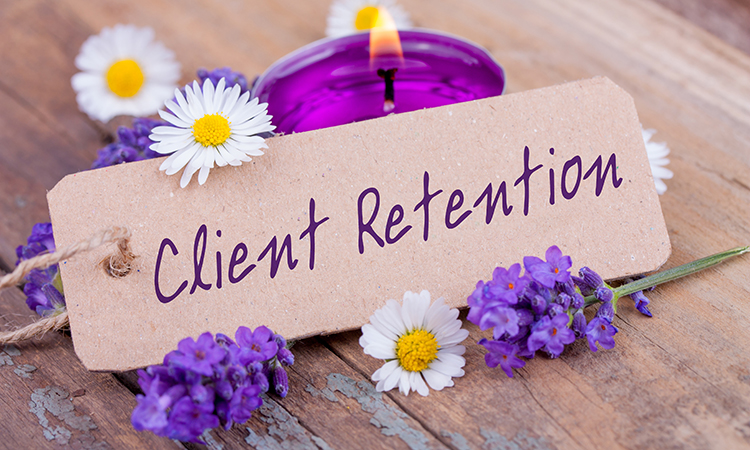
Client retention is a phrase that is often thrown around in the wellness industry. What’s the big deal about client retention, anyway? You spend a good amount of time, money and resources to bring in new clients each week, so who really cares if existing clients choose to come back or not?
Well, that’s just it: Bringing in new clients takes your time, money and resources—and quite a bit of each.
While it may be true no business can thrive without bringing in new clients, if you can retain your existing client base, then you’ll end up reducing your costs (and improving your return on investment) in the long run.
So it’s settled then: Simply keep more clients coming back. This sounds easy enough—surely providing fantastic massage services is enough to keep clients coming back for more, right? But if you’ve been practicing massage for longer than, say, five minutes, you probably realize it’s not exactly this cut-and-dried.
What can you do, other than offer a great experience, to improve client-retention numbers?
The first step is realizing there is such a thing as a client lifecycle. Your client base is not all that different from a tadpole’s transformation into a frog. And just like a tadpole has different needs than a full-fledged frog, a client in each stage of the lifecycle needs a customized client-retention strategy.
The three stages are: The first contact, or the first 30 to 60 seconds of interaction with your business; new to your business, the first one to three visits or 30 to 60 days; and ongoing clients, those who have made more than three visits or been clients for more than 60 days.
The first contact

Because of the resources spent to gain new clients, many businesses neglect this first and arguably most-important stage in the consumer lifecycle. During this stage, you have, at most, 60 seconds to make a good first impression. Most of the time, this won’t include any portion of the actual massage service.
Rather, this is the first phone call, e-mail, website visit or personal interaction with you or your front-desk staff. That’s right, new clients don’t always walk into your place of business. In fact, the first 30 to 60 seconds spent interacting with your business generally isn’t spent with another human at all.
Making a great first impression is more than having a smiling face greet new clients who walk through the door. The cardinal rule of making the first interaction a successful one is to never make new clients (or any clients, for that matter) work to find information.
From your answering machine to your website, frequently asked questions should be addressed in a simple and straightforward manner.
Some things to address include a description of your services, pricing, hours of operation, contact information, how one should prepare for the first massage and what to expect during the first session. Ask yourself, your staff, even your clients to determine what the most common questions are for your particular business.
Your website is a crucial aspect in making a great first impression. Five years ago, it may have been acceptable to have a static website with your phone number and address. Now websites like this, while better than no website at all, are extremely outdated. As your clients become more Web savvy, your website should change to match their needs.
The concept of striking iron while it’s hot—or capitalizing on an opportunity—should be readily available to clients who visit your site. Offering information-capture forms and newsletter signups on your page will ensure you obtain a potential client’s contact information if he visits your website but doesn’t want to call.
Offering online booking allows clients who access your website outside of business hours to avoid phone tag, and it lets you benefit from emotional buying. Spend a little time and money (or trade services) with a Web designer and you’re guaranteed to retain some of the visitors who may have left your website after only a few seconds.
New to your business

Once you get a new client to come through the door for a first visit, your next objective is to keep her there. The next phase of your client’s lifecycle occurs just after that first interaction with your business.
Most businesses recognize this stage as a delicate one and will focus the majority of effort on this category of client. But again, your retention strategy here can’t consist solely of fantastic massage services, although that definitely helps. Your strategy should consist of staying connected to your new clients and encouraging commitment to your business.
Why does staying connected to your clients encourage them to come back? Establishing a way to communicate with clients will keep your business at the forefront of their minds. And then when most people think of massage, they’ll say to themselves, “I could use one of those right about now.”
You can connect with your clients in a number of ways, and one of the easiest is to use a fairly standard feature of any massage business-management software: automated e-mails and text messaging. These little gems can be sent out to remind clients of upcoming appointments, to confirm a booking, even to wish them a happy birthday or to remind them to book their next appointment.
Automated e-mails are not only helpful to the client, but are also a great micro- marketing tool when coupled with promotional codes and offers.
It’s also possible to stay connected with clients through education. Many first-time massage clients aren’t aware of the benefits regular massage can have on their overall wellness routine. Educating clients on the health benefits of massage, as well as different types of massage, can lead to them incorporating it more regularly into their lives.
Another benefit of education to your client-retention strategy is when your clients look to you as an educational resource, they are less likely to shop around for massage services elsewhere.
Tracking any interaction you or your staff may have with your clients is an important part of staying connected. If you are a solo practitioner, then you may know each of your clients by name and may be able to recall conversation details from weeks prior. But if you operate a larger business, then eventually your client interactions will graduate to some level that can no longer be handled with your memory or with Post-it notes.
Tracking interactions, through your massage business software or through another system, will professionalize your practice and let your clients know their opinions, problems and suggestions are important to you.
And feeling important is a key factor in client retention.
During this stage of a client’s lifecycle, fostering a commitment to your business is one of the best ways to increase client retention. If clients view massage as part of their overall wellness routine, then they are more likely to book in advance and plan for the expense in their budget.
This is a driving factor behind one of the more recent industry trends of offering massage memberships.
You’ve seen it in other industries—health clubs and yoga studios, for example—for years. The membership model is becoming more popular in the massage industry because it’s a win-win situation: Your clients benefit from regular massage and appreciate the discount a membership generally provides, and you benefit from more committed clients who book more often.
Ongoing clients

This is the last stage of the client lifecycle; it’s where you want all first- timers and newbies to end up. Many businesses work hard to retain their new clients, just to forget about them once they reach the status of a long-term client. Just like the first two stages of the client lifecycle, the third and final stage of an ongoing client needs its own, customized client-retention strategy that focuses on great customer service.
We’ve all heard dozens of strategies on what makes great customer service— most of them at age 15, from the manager at our first job waiting tables. But let’s first redefine the term customer service.
It’s not the department that deals with complaints, but rather the proactive—not reactive—process of building a relationship with your clients, of learning what they want and creating a community.
Great customer service begins with learning what your clients want, and the best place to start is by asking your clients. Solicit feedback in the form of asking them directly, a suggestion box or an online survey. Also, check with your frontline staff and service professionals. Once you receive feedback, respond to it. Let clients know their opinions matter; this will ensure you continue to receive feedback.
When you receive negative feedback, respond in a manner that acknowledges how your client is feeling with a “how can I make this better” attitude. Your client may or may not be in the right, but it doesn’t matter. The fact is she is upset and your job is to recognize this and work with her to find an appropriate solution. It’s important to train your staff to diffuse complaints.
An effective way to do so is to empower staff to solve problems immediately, without having to contact management, by giving them a ceiling (say $50) with which they are authorized to credit upset clients.
If you’re able to turn the situation around and make your client happy, she’s not only going to come back, but is also likely to refer your business to others.
Once clients reach this stage in their lifecycle, you’ll notice a higher-than- average retention rate. However, you’re still bound to see lapsed clients, those who have inexplicably stopped booking massages.
If you’re using software to run your business, then there is likely a report that will allow you to see those clients who haven’t visited within a certain period of time. Send them an e- mail with a special promotion. Reaching out to lapsed clients will let them know they are missed and you’ll see your retention numbers rise when they book their next massage.
When it comes to massage, no two clients are alike. Every individual has unique needs and will benefit from massage in a slightly different way; just as you use different methodologies of massage to accomplish different forms of healing, you should be using different strategies of client retention to keep clients coming back to your business.
About the Author
Danielle Murphy is the online marketing program manager for MINDBODY, an online massage-business-management software company. Prior to marketing, Murphy consulted with business owners on how to most effectively use MINDBODY to manage their wellness businesses. Learn more about MINDBODY at www.mindbodyonline.com.
If you enjoyed reading this MASSAGE Magazine online article, subscribe to the monthly print magazine for more articles about massage news, techniques, self-care, research, business and more, delivered monthly. Subscribe to our e-newsletter for additional unique content, including product announcements and special offers.